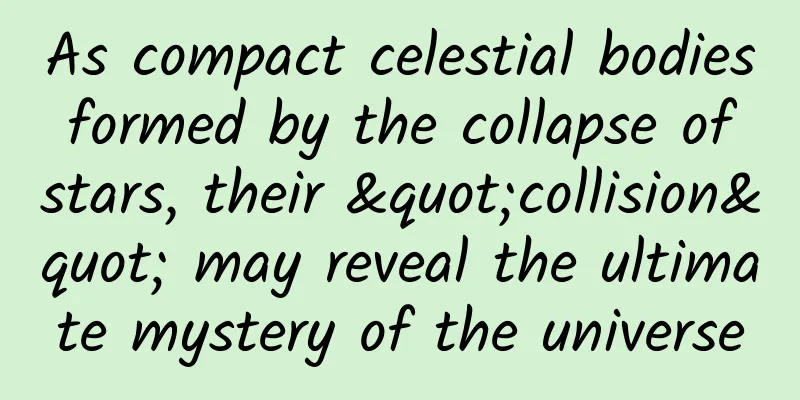As compact celestial bodies formed by the collapse of stars, their "collision" may reveal the ultimate mystery of the universe

|
Author: Duan Yuechu A neutron star is an extremely dense celestial body, usually formed from the matter left after a star explodes. Its name comes from the fact that most of its mass is made up of neutrons. The mass of a neutron star is generally between 1.4 and 2 times the mass of the sun, but its diameter is only about 20 kilometers. Its density is extremely high, reaching the density of tens of millions of Earths. In contrast, a black hole evolves from an extremely massive celestial body, and its gravity is so strong that even light cannot escape its range of influence, so it cannot be directly observed. The formation mechanisms of neutron stars and black holes are different. Neutron stars usually come from stars with a mass of 1.4 to 8 times the mass of the sun. After the star explodes, the internal matter is squeezed to the limit, forming an extremely dense neutron star. Black holes evolve from stars with larger mass. After the star has exhausted all its nuclear fuel, it cannot resist the internal gravity and collapses to form a black hole. The formation mechanisms of these two celestial bodies are obviously different, which also creates the mass gap between them. The mass gap has a profound impact on interstellar evolution. In the process of stellar evolution, the mass gap determines its final fate. Stars with smaller masses tend to evolve into neutron stars, while stars with larger masses may evolve into black holes. This different evolutionary path directly affects the distribution of interstellar matter and the structure of galaxies, and is of great significance to the evolution of the universe and cosmological research. In order to detect neutron stars and black holes, scientists rely on a variety of advanced astronomical equipment and technologies. Among them, X-ray telescopes and gravitational wave detectors have become important tools for detecting neutron stars and black holes. X-ray telescopes can detect black holes and neutron stars by detecting high-energy X-rays, because both celestial bodies can release a large amount of X-rays. For example, the supernova explosion observed by NASA's Chats X-ray Observatory revealed the existence of neutron stars. Gravitational wave detectors can detect gravitational waves released when stars collide or lose mass, which also makes it possible to discover black holes and neutron stars. In 2015, LIGO detected the first gravitational wave signal in human history, which marked the birth of gravitational wave astronomy and opened up new ways to detect black holes and neutron stars. The mass gap between neutron stars and black holes is of great significance for our understanding of the evolution and structure formation of the universe. First, by studying the evolutionary relationship between them, we can better understand the life cycle of stars and the formation process of different celestial bodies after the death of stars, thereby deepening our understanding of the universe, especially stellar evolution. Secondly, the mass gap between neutron stars and black holes is also directly related to the distribution and morphology of galaxies and interstellar matter, and has important guiding significance for studying galaxy evolution and cosmic structure. In addition, through the study of the mass gap between neutron stars and black holes, we can also verify and improve the theory of gravity and find new physical laws, which is also of positive significance for promoting the development of basic physics. In the future, research on the mass gap between neutron stars and black holes will continue to deepen. First, we can further upgrade the gravitational wave detector to improve its detection sensitivity, in order to observe more merger events of black holes and neutron stars. Secondly, develop more advanced astronomical equipment and detection technologies, such as ultra-high energy telescopes and space telescopes, to enhance the observation capabilities of neutron stars and black holes. Finally, we can also further explore the specific mechanism of the formation of neutron stars and black holes, and the impact of the mass gap between them on the evolution of the universe through simulation experiments and theoretical deductions. Through these efforts, we hope to have a more comprehensive understanding of the "mass gap" between neutron stars and black holes, reveal more cosmic mysteries, and promote progress in the field of cosmology. |
>>: In order to eliminate static electricity, I painted the wall at the door black...
Recommend
The young man was deceived into becoming a "blood slave" in Cambodia! What are the harms of multiple large-dose blood draws to the body?
|||| Written by reporter Duan Dawei Edited by Liu...
More than 100,000 users added in 5 days, revealing the "payment + fission" routine in the education industry!
Fission is a very popular concept this year, on p...
World Animal Day | The first "person" who "fishes" in animals, seemingly standing, but actually sleeping
Every year on October 4th, World Animal Day is a ...
Beware! Internet celebrity "Bug Agent" is sneaking into China... Netizen: This picture scares me!
The reporter learned from Chengdu Customs on the ...
【Responsive website development】Achieve multi-terminal compatibility at a low cost
Chapter 1: Course Introduction 1.1: Talking about...
Look! China's most magnificent animal wonders
This is the most magnificent animal wonder in nat...
"Understand operations and do marketing" - three steps to operational strategy
In the early days of mobile Internet , the earlie...
User Activation: Breaking Down Luckin Coffee’s New User Activation Process
There are many ways to attract new customers to y...
Short video promotion tips for Huoshan, Kuaishou, Douyin, etc.!
Traffic is the focus of everyone's attention ...
8 insights from Douyin e-commerce new brand growth report
The new consumption track in the past two years h...
Insights | Only by keeping calm can you achieve great things
Famous Artists Gallery | Grice, a Russian painter...
Mini-app development for Guangzhou housekeeping and cleaning companies
Guangzhou housekeeping and cleaning companies are...
World population reaches 8 billion!
The United Nations World Population Prospects 202...
A look at the pain of Khwarezm in start-up companies from Zhou Houjian's 1,000-word email
In the tide of entrepreneurship, there are so man...









